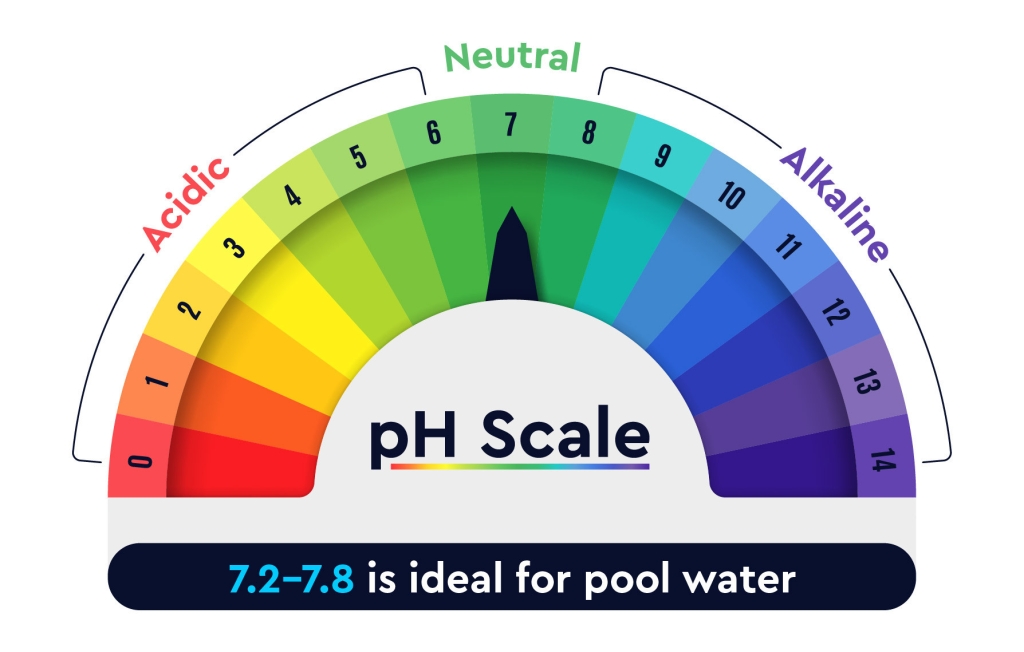What You Need to Know About Swimming Pool pH Balance
A swimming pool is an exciting addition to any home that, when looked after properly, can boost your health, enhance your lifestyle, and improve the look of your property.
To maximize these benefits, maintaining the proper pool pH balance is crucial for both the health of the pool and the wellbeing of the swimmers, so you and your family can enjoy safe swimming for many years to come.
This article will delve deeper into the importance of pH balance, as we explain how to test and adjust the pH levels so you know exactly what is required.

What is pH?
The pH scale measures how acidic or alkaline a solution is by assigning a numerical value to it. The numbers run from 0 – 14, with lower numbers indicating higher acidity and higher numbers indicating higher alkalinity. The number 7 refers to a neutral solution that is neither acidic nor alkaline.
Why is pool pH important?
The pH level of your pool water impacts the effectiveness of chlorine, which is essential for keeping the water clean and free of bacteria. If the pH is too high or too low, the chlorine becomes less effective, leading to an increased risk of bacteria growth and algae formation.
High pH levels can cause skin and eye irritation, while low pool pH levels can corrode pool equipment and damage the pool surface.
Worried About Your Pool's pH Balance?
Don't risk your pool's health—call our experts now to ensure precise pH balance and optimal water quality for a sparkling, safe swim every time.
Request Your Maintenance QuoteIs pH more important than alkalinity?
Alkalinity refers to the amount of alkaline substances in the pool that are able to withstand or ‘buffer against’ pH changes. Both are important for maintaining a healthy and swimmable pool, but since alkalinity has a big effect on pH, you want to ensure it’s correct first.
What causes high pH?
High pH occurs from general use as when you move about in a pool, carbon dioxide is lost, reducing the amount of carbonic acid formed, and thus raising the pH. Various chemicals used to treat a pool can also influence the pH levels.
What causes low pH?
If your pool has been left unmoving and stagnant for a while, atmospheric carbon dioxide will dissolve into the water, raising the carbonic acid levels — and therefore lowering the pH. Certain cleaning substances that are added to the water can also decrease the pH levels.
Maintaining pH balance
 The ideal pool water pH is between 7.2 to 7.8 which makes it safe for use. However, this requires maintenance to ensure it stays at those levels. Let’s take a look at how you can maintain the pH of your pool.
The ideal pool water pH is between 7.2 to 7.8 which makes it safe for use. However, this requires maintenance to ensure it stays at those levels. Let’s take a look at how you can maintain the pH of your pool.
- Testing: Regularly testing the chemical balance of your pool is crucial to ensure it stays sanitized and at the recommended pH level. While home test kits can provide a snapshot of the water chemistry, they don’t provide a complete analysis like a pool professional can and who will test for chlorine, pH, alkalinity and calcium hardness. It is recommended to test the pH level of your pool water at least once a week, especially during peak swimming season, and also after heavy rainfall.
- Adjusting: If the pH level of your pool water is too high, an acidic chemical, such as muriatic acid or sodium bisulfate, should be added. If the pH level is too low, an alkaline chemical, such as sodium carbonate, will increase pool pH. Handling chemicals such as these requires great care, so always follow the manufacturer’s instructions or hire an expert to help. Add the chemicals slowly and in small amounts, testing the pH level frequently until the desired level is reached. Avoid adding too much chemical at once, as this can lead to overcorrection of the pH level.
Maintaining the proper pH balance of your pool water is crucial for keeping the water clean, clear, and safe for swimming. Testing the pH level regularly and making adjustments as needed can prevent problems such as bacteria growth, algae formation, and equipment damage.
By following the guidelines above, you can ensure that your pool remains at an optimal pH level, providing a safe and enjoyable swimming experience for all.
Searching for a reliable pool maintenance company in Plano, Dallas, McKinney, or the surrounding areas? Contact our experienced team at Riverbend Sandler Pools today. With over 40 years’ experience as the go-to pool experts for the area, we ensure your pool is safe, swimmable, and hygienic all year round.
